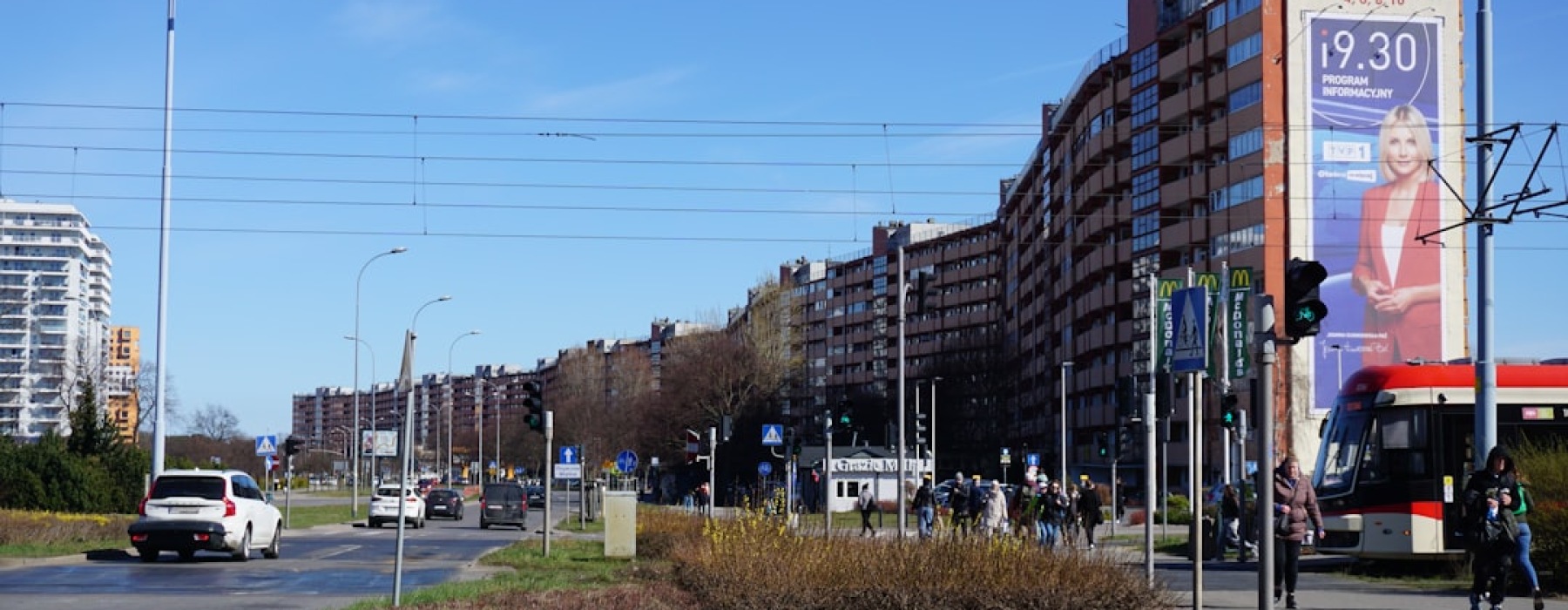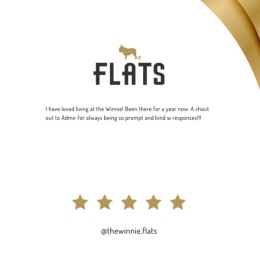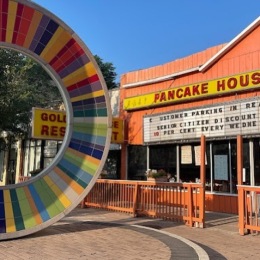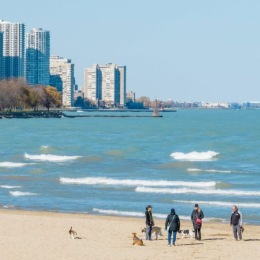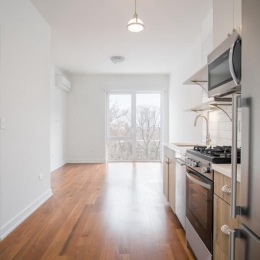Why Transit-Accessible Living Is the Smart Choice
Apartments near bus stops offer the perfect blend of convenience and affordability for today's urban dwellers. With properties located within a 5-minute walk to major bus stops among the most sought-after rentals, it's clear that transit accessibility has become a top priority for renters.
Key benefits of living near bus stops:
- Shorter commutes - Cut travel time to work, school, and entertainment
- Lower transportation costs - Reduce or eliminate car expenses
- Higher property values - Transit-adjacent apartments often command premium rents
- Better lifestyle - More time for activities you actually enjoy
- Environmental impact - Eco-friendly travel reduces your carbon footprint
The data backs this up: apartments near major transit hubs like Don Mills Station in Toronto show hundreds of available listings, while properties with high transit scores (like 80% in North York) are consistently in demand.
Cities from Chicago to Toronto are seeing massive growth in transit-oriented development. Student-focused communities especially emphasize bus stop proximity - some properties even have stops directly in front of their buildings.
Whether you're looking for a budget-friendly studio or a family-sized unit, proximity to reliable public transit opens up more neighborhood options while keeping your commute manageable.
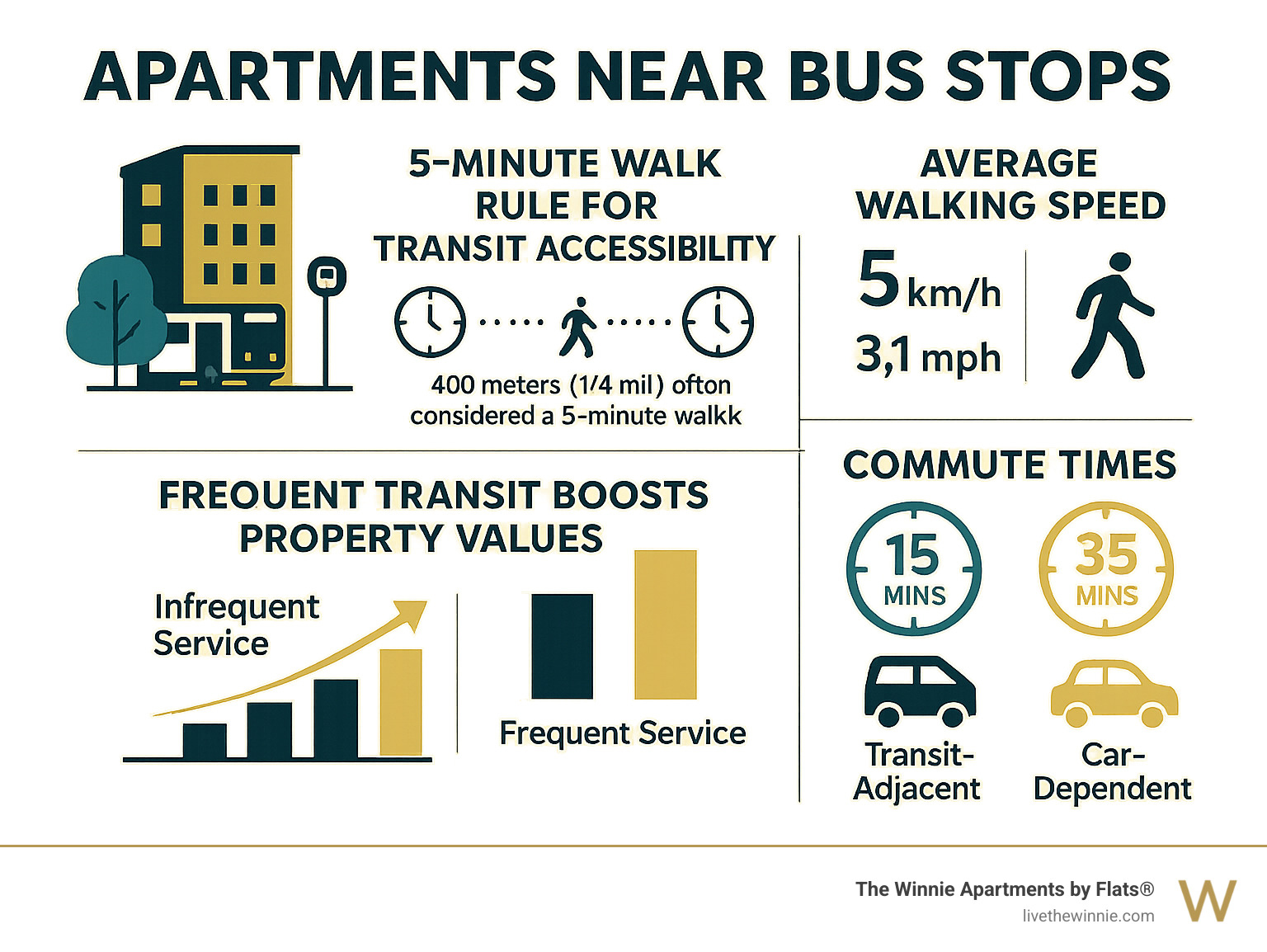
Why Living Steps from Transit Is Life-Changing
Picture this: instead of sitting in traffic for 45 minutes, you're walking 5 minutes to catch a bus that gets you downtown in 20 minutes. That's the reality when you choose apartments near bus stops – and it changes everything about how you live.
Time suddenly becomes your friend when you're not battling rush hour traffic. Properties with strong transit access, like those boasting an 80% transit score and 54% walk score found in areas like North York, turn your daily commute into something manageable. While your friends are still looking for parking, you're already at your destination with extra time to grab coffee or take a relaxed walk.
Your bank account gets a serious boost when you can ditch the car dependency. Between gas prices, insurance premiums, parking fees, and those surprise repair bills, urban car ownership can drain thousands from your budget each year. A monthly transit pass costs a fraction of that, and many employers sweeten the deal with transit subsidies.
Walking to the bus stop becomes your daily dose of exercise without even trying. Those 5-10 minute walks twice a day add up to meaningful physical activity that fits naturally into your routine. Plus, there's something genuinely stress-relieving about not having to worry about traffic jams or finding a parking spot.
Pet parents find a whole new level of convenience in transit-friendly neighborhoods. Higher walk scores mean more places to explore with your furry friend within a reasonable distance. Many properties near transit stops recognize this and include thoughtful pet amenities like dog runs and washing stations.
Going green feels good when it also makes practical sense. Using public transit dramatically cuts your carbon footprint compared to driving solo. Transit-accessible neighborhoods often feature more walkable amenities too, so you'll find yourself needing the car less and less.
The lifestyle shift is real – and once you experience the freedom of easy transit access, it's hard to imagine going back to car-dependent living.
More info about public transport services can help you understand specific transit options in your area.
Best Apartments Near Bus Stops by Unit Type
Finding the perfect apartments near bus stops depends on your lifestyle and space needs. Whether you're a student looking for your first place or a growing family wanting urban convenience, transit-accessible buildings offer options that make city living both practical and enjoyable.
The beauty of living near transit is that it works for everyone. Single professionals love the freedom from car payments, while families appreciate the easy access to schools and activities without the stress of downtown parking.
Studio Apartments Near Bus Stops
Studio living near bus stops is like having the entire city as your extended living room. When you can hop on a bus and reach cafes, libraries, and parks within minutes, your compact space feels much larger than its square footage suggests.
Budget-conscious renters find studios near transit offer unbeatable value. You're paying for location and convenience rather than extra bedrooms you might not need. Many buildings sweeten the deal with move-in specials specifically for studio units, recognizing that smart renters prioritize accessibility over space.
The compact living approach works especially well when you're steps from a bus stop. Your morning routine becomes streamlined - no hunting for parking spots or scraping ice off windshields. Just grab your coffee and catch the next bus.
Students particularly benefit from this setup. Some properties even have bus stops directly outside their front doors, making those early morning classes much more manageable. When you're juggling school and work, every minute of sleep counts.

Smart studio layouts in transit-friendly buildings often include clever storage solutions and multi-functional furniture. Developers know that studio renters are choosing lifestyle over square footage, so they invest in thoughtful design that makes every inch count.
Family-Sized Apartments Near Bus Stops
Two and three-bedroom apartments near bus stops prove that families don't have to choose between urban convenience and comfortable living space. These larger units typically offer the best of both worlds - room to spread out and easy access to the city's opportunities.
Extra storage becomes a key feature in family-sized units near transit. Since you might not have a garage or basement, smart buildings include storage cages, walk-in closets, and built-in organizational systems. Families need space for everything from strollers to sports equipment.
Parking options vary depending on the building's approach. Some family-friendly properties include parking spaces, recognizing that families often need cars for grocery runs or weekend trips. Others focus entirely on transit access and pass the parking savings on to residents.
Play areas and family amenities make these buildings feel like complete communities. Rooftop decks, community rooms, and outdoor spaces give children safe places to play while parents appreciate not having to drive to every playground or activity.
The demand for family layouts near transit stays consistently high. Three-bedroom units especially tend to fill quickly, as families find that bus access makes city living with kids not just possible, but enjoyable.
Cities & Neighborhoods with Unbeatable Bus Connections
Some cities just get it right when it comes to apartments near bus stops. These places have figured out how to weave public transit so seamlessly into neighborhoods that you barely notice the difference between hopping on a bus and walking to your corner store.
Chicago's Uptown neighborhood stands out as a perfect example of how transit should work. Multiple bus routes crisscross the area, connecting residents to the Red Line and creating a web of options that means you're never stuck waiting too long. The neighborhood buzzes with energy - tree-lined streets mix with busy commercial strips, and you can grab everything from late-night tacos to artisanal coffee within walking distance of most apartment buildings.
Head north to Toronto's North York, and you'll find suburban living that doesn't sacrifice connectivity. Properties here boast impressive 80% transit scores, which means getting downtown takes about as long as it would take some people to find parking. The genius is in the layered approach - bus routes feed into subway stations, creating backup options when one line runs late.
Mississauga's Meadowvale area proves that even car-centric suburbs can accept transit-friendly living. Residents enjoy 10-minute walks to GO stations and 5-minute strolls to transit terminals. It's the sweet spot for people who want a backyard and a barbecue but don't want to spend their lives stuck in traffic.
Don't overlook smaller cities like Cambridge, Ontario, where 28 apartment listings specifically highlight their bus stop proximity. When a smaller city makes transit access a selling point, you know they're serious about giving residents real alternatives to driving everywhere.
Portland's downtown core near SW Park Avenue showcases urban transit at its finest. The precision here is impressive - apartments sit just 0.07 to 0.24 miles from multiple bus lines and MAX light rail. That level of detail helps renters understand exactly what "close to transit" actually means.
Cleveland's W 65th St-Lorain Avenue Station area offers 38 different apartment options near GCRTA transit, proving that mid-sized cities can create diverse housing choices around public transportation. The variety means everyone from students to families can find something that works.
San Francisco's Van Ness corridor takes redundancy seriously, with access to bus routes 2, 28, 30, 47, and 49. When you have that many options, a delayed bus becomes a minor inconvenience rather than a major headache.
Detailed stop maps can help you explore specific transit options in Portland and other cities, giving you the real picture of what your daily commute might look like.
How to Find & Compare Apartments Near Bus Stops
Finding the perfect apartments near bus stops takes more than just typing "near bus stop" into a search bar. The smart approach combines technology with real-world testing to find a place that truly fits your lifestyle.
Search filters on rental websites have gotten surprisingly sophisticated. You can now filter by actual commute time during rush hour, not just distance. Set your workplace as the destination and watch as properties get ranked by how long it'll actually take you to get there on a Tuesday morning. This beats guessing about transit connections every time.
Transit and walk scores give you the numbers behind the convenience. Those properties in North York with 80% transit scores and 54% walk scores aren't just marketing fluff - they represent measurably better access to buses, trains, and walkable destinations. Still, don't stop at the scores. Make sure the specific bus routes actually go where you need them to.
The commute-time calculators built into rental platforms now factor in rush hour delays, transfers, and even walking time to stops. They're not perfect, but they'll save you from finding that your "convenient" apartment actually requires two transfers and a 15-minute walk during your first week of work.
Noise levels become a real consideration when you're steps from busy bus routes. That convenient location might come with the 6 AM bus announcements and late-night passenger chatter. The sweet spot often lies just slightly back from the busiest stops - close enough for easy access, far enough for peaceful sleep.
Safety around transit stops varies dramatically between neighborhoods. Look for stops with good lighting, security cameras, and regular foot traffic. Properties with controlled building access and on-site management add extra peace of mind, especially if you'll be coming home late from work or social events.
Parking situations at transit-adjacent buildings run the full spectrum. Some include parking because they recognize you might still need a car occasionally. Others charge extra for spaces, and some offer none at all, banking on their transit access. Be honest about your actual car needs before you decide what works for you.
Virtual tours help narrow down your list, but pay attention to which direction windows face. Units overlooking busy transit streets might deal with more noise and activity, while those facing courtyards or quieter side streets often provide the best of both worlds.
Pet policies at transit-friendly buildings often reflect their urban-minded residents. Many welcome pets and include thoughtful amenities like dog washing stations and nearby parks accessible by bus. If you have pets, these features can make daily life significantly easier.
Utilities included in your rent can vary quite a bit, though water and heat commonly come bundled with transit-accessible apartments. This simplifies your monthly budget and can represent real savings, especially during those brutal winter months when heating bills spike.
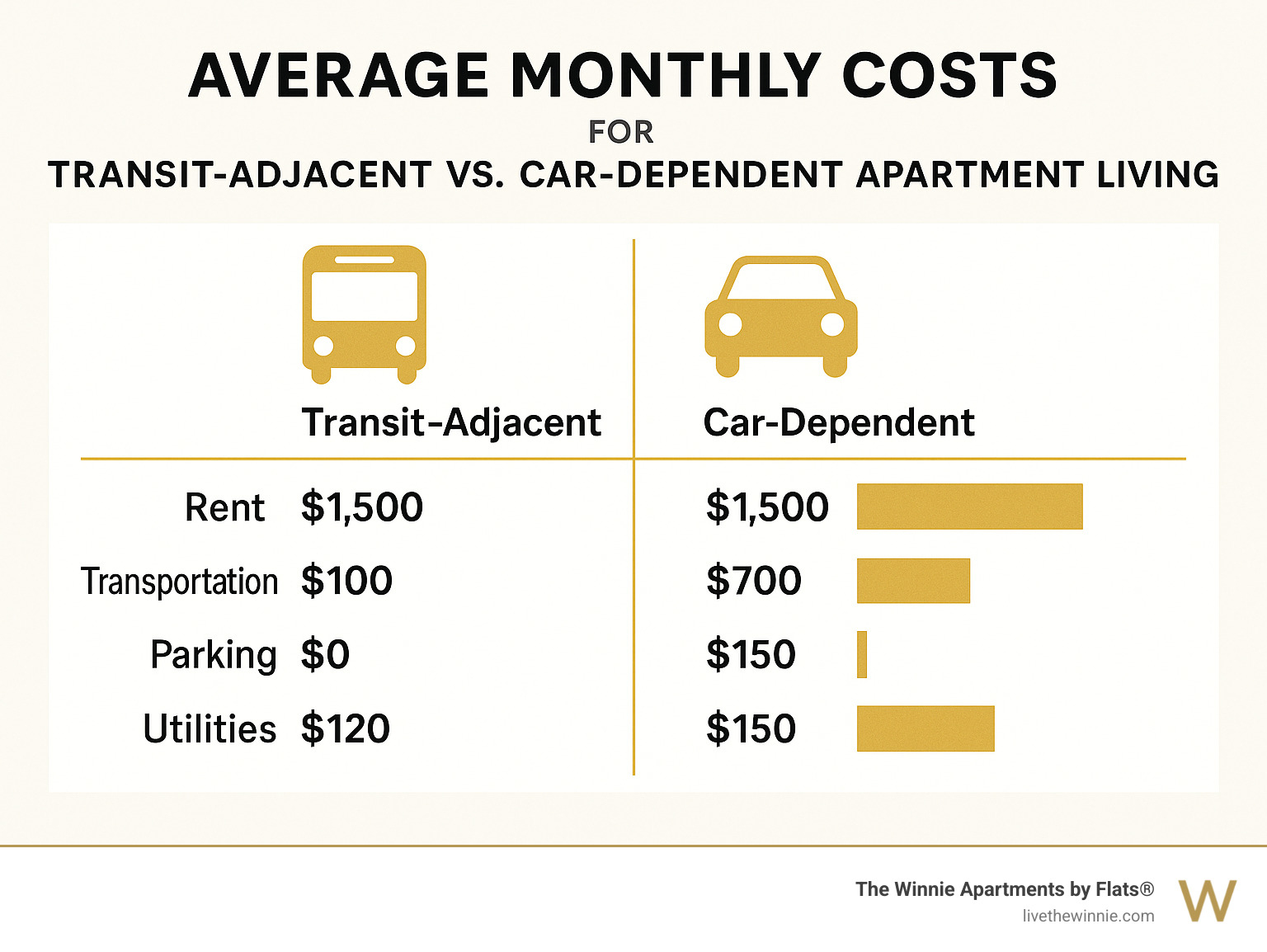
Smart Hacks for Apartments Near Bus Stops
Draw-boundary mapping on rental sites lets you get specific about your walking tolerance. Instead of searching entire neighborhoods, you can create a custom area around transit stops that matches your actual willingness to walk. Most people find 5-10 minutes comfortable for daily commuting.
Search alerts become your secret weapon in competitive rental markets. Set up notifications for new listings that meet your transit and apartment criteria, then respond within hours rather than days. The best apartments near bus stops often get snapped up quickly by renters who understand their value.
Rush hour testing reveals what your daily life will actually feel like. Take the bus routes you'd use regularly, time your walks to stops, and see how crowded things get during peak hours. A route that looks perfect at 2 PM might tell a different story at 8 AM.
Multiple route options provide backup plans when your primary bus runs late or gets cancelled. Many transit-accessible apartments offer access to several lines, giving you flexibility when the unexpected happens.
Schedule a Tour to experience properties and ask specific questions about transit access, neighborhood noise levels, and local amenities that matter to your daily routine.
Frequently Asked Questions about Apartments Near Bus Stops
Do apartments near bus stops cost more than similar units farther away?
Apartments near bus stops do typically cost more upfront than similar units in less connected areas, but here's the thing - you often come out ahead financially when you look at the bigger picture. The transit premium exists because these spots are genuinely more convenient and desirable.
The actual cost difference depends heavily on your specific city and how good the bus service really is. Units near major transit hubs with frequent, reliable service command the highest premiums, while those near less frequent routes might only cost slightly more than car-dependent alternatives.
But here's where the math gets interesting - eliminating car ownership can save you hundreds of dollars monthly. No car payments, insurance bills, gas costs, or parking fees means more money stays in your pocket. Many transit-accessible buildings also include utilities like water and heat, adding even more value.
The sweet spot often lies in apartments that require a 10-15 minute walk to transit rather than those right at the stop. You still get excellent connectivity but often pay less rent while avoiding the noise and crowds of the busiest transit areas.
Are apartments near bus stops generally pet-friendly?
Transit-accessible apartments tend to welcome pets more often than car-dependent housing, and there's a practical reason for this. The walkable neighborhoods around bus stops create better experiences for pet owners, with parks, vet clinics, and pet stores all reachable via transit.
The higher walk scores typical of transit-adjacent areas mean more opportunities for dog walks right in your neighborhood. Many properties near bus stops have caught onto this trend, adding pet amenities like washing stations, dog runs, and even pet-friendly community events.
That said, pet policies still vary significantly between buildings. Some charge monthly pet fees, others require deposits, and a few maintain breed restrictions. The key is asking about specific policies upfront, including any additional costs, since these can add to your monthly housing expenses.
The convenience factor really shines when you need to get your pet to the vet or grooming appointments. Instead of loading a stressed cat into a car, you might be able to walk to nearby services or take a short bus ride to pet-friendly destinations.
What utilities are typically included when you rent near public transit?
Transit-adjacent apartments commonly include more utilities than you might expect, particularly water and heat. This reflects both the urban apartment building designs common in these areas and the simplified lifestyle that transit-oriented renters often prefer.
Water inclusion is nearly universal in apartments near bus stops, while heat inclusion depends largely on your climate and building type. Larger apartment buildings in colder areas almost always include heat, since it's more efficient to heat the entire building than manage individual units.
Many newer developments near transit also include basic cable or internet packages, recognizing that their tech-savvy residents expect connectivity. Trash and recycling services are standard in most apartment buildings regardless of location.
Electricity typically remains separate, giving you control over your usage and costs. This arrangement works well for most renters since it encourages energy conservation while keeping the biggest utility variables - heating and water - predictable.
The utility inclusion simplifies your monthly budgeting significantly. Instead of juggling multiple utility bills and deposits, you get one predictable rent payment that covers most of your basic needs.
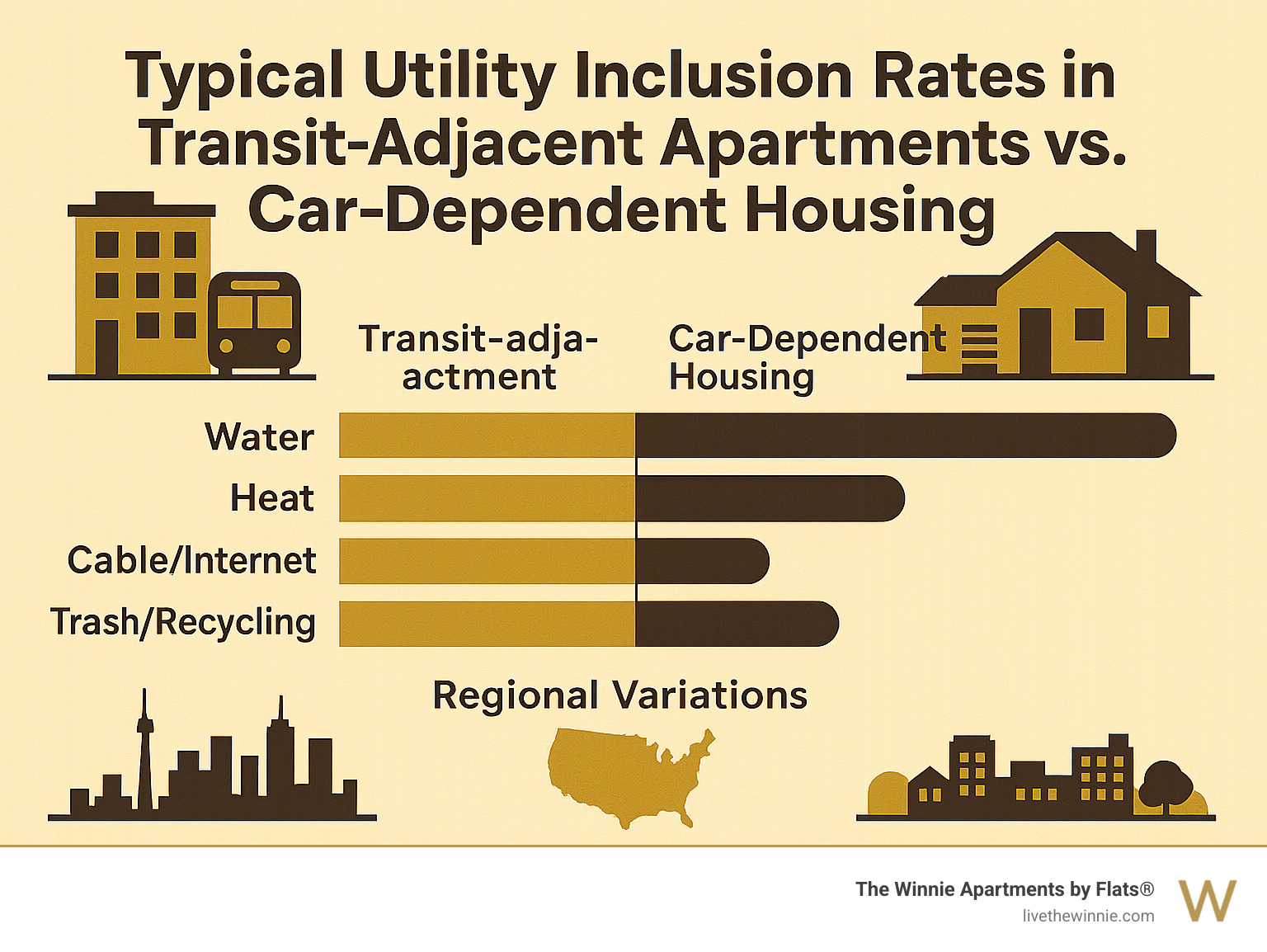
Conclusion
Finding the perfect apartments near bus stops transforms your daily life in ways that go far beyond just getting to work on time. Throughout our exploration of transit-accessible living, we've seen how the right location creates a lifestyle that's more convenient, more affordable, and simply more enjoyable than traditional car-dependent housing.
The numbers don't lie - properties within walking distance of reliable bus service consistently rank among the most desirable rentals in major cities. From the family-friendly appeal of spacious units near transit hubs to the budget-smart choice of studios with easy commute access, transit-oriented living works for every stage of life.
The financial benefits alone make a compelling case. When you add up the savings from reduced transportation costs, included utilities, and the premium amenities that many transit-accessible properties offer, the total value often exceeds what you'd get from cheaper rent in less convenient locations.
But the real magic happens in those everyday moments - catching an early morning bus without the stress of traffic, having extra time in your day because your commute is predictable, or finding new neighborhoods simply because they're accessible via your regular bus routes.
At The Winnie Apartments by Flats®, we've designed our Uptown Chicago community around exactly this philosophy. Our modern studio and one-bedroom apartments put you within easy reach of multiple bus routes and CTA connections, while our thoughtful amenities ensure your home feels like a retreat from the urban energy just outside your door.
The Uptown neighborhood perfectly embodies what makes transit-accessible living so appealing. You get the authentic Chicago experience with tree-lined streets, local cafes, and community character, all while staying connected to downtown and beyond through reliable public transportation.
Your morning routine becomes simpler, your budget stretches further, and your weekends open up with possibilities when you're not tied to car payments and parking hassles. This is urban living done right - where convenience meets comfort without forcing you to choose between the two.
Ready to experience how much easier city living can be when everything you need is within reach? Schedule a Tour and see why The Winnie Apartments by Flats® residents love calling Uptown home. Come find the difference that truly convenient living makes in your daily routine.


